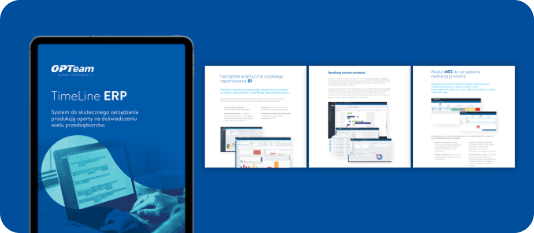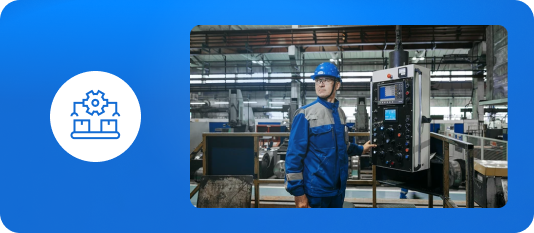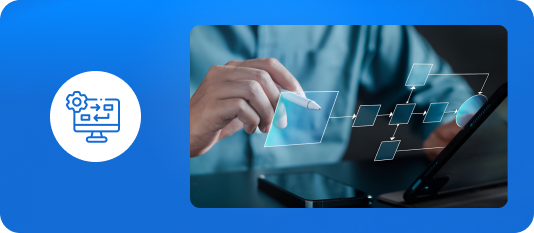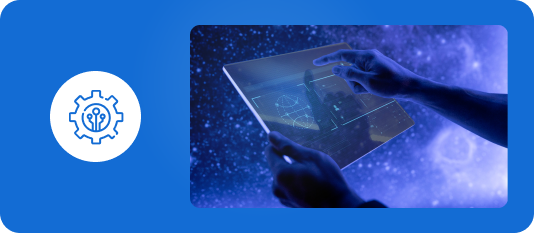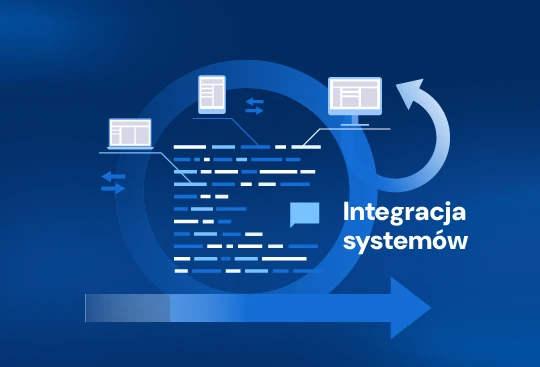How to create a reliable application infrastructure around your ERP system
In today's dynamically changing business environment, effective management is crucial to the success of every company. Enterprise Resource Planning (ERP) systems play a crucial role in this context, enabling the integration and even automation of multiple business functions within a single system.
This system enables more efficient management of resources, production processes, finances, logistics, and customer and supplier relationships. However, despite its versatility, sometimes it becomes necessary to implement additional solutions, and more importantly, the latest technologies, which will improve and maximize the potential of ERP systems in an increasingly automated and digital world.
Employing an ERP system alone is not always sufficient to meet all the challenges of the modern market. Therefore, companies must seek additional opportunities for process optimization. This means that expanding the ERP system with complementary applications is becoming a necessity, as is adopting the latest technologies, which were previously considered a thing of the past.
Expanding ERP systems with additional complementary applications
Manufacturers of ERP systems, functionally adapted for comprehensive enterprise management, understand the need for solutions that complement their systems. Therefore, they offer native applications that complement ERP functionality and work closely with it. Complementary applications built using the same technology enable integration and, as a result, the development of a comprehensive IT infrastructure.
Comarch is one of the ERP system manufacturers that also offers the option of complementing their modules with dedicated applications. In addition to Comarch ERP XL and Comarch ERP Enterprise, integrated enterprise management software, it offers a suite of additional tools designed for key business areas. These include Comarch HRM, Comarch CRM, Comarch BI Point, Comarch WMS, and Comarch e-Commerce. Integration of these applications with ERP is achieved through data exchange and interoperability between various modules via APIs (Application Programming Interfaces). This allows various applications to communicate with each other and with the main ERP system, ensuring data consistency and eliminating the need to manually enter information into different systems.
Comarch HRM: Effective human resource management
Comarch HRM (Human Resource Management) is an advanced application designed for human resources management in enterprises. Part of the Comarch ecosystem, the application allows for full integration with the company's ERP system, ensuring stable collaboration and the smooth exchange of consistent data.
Integrating Comarch HRM with an ERP system brings numerous benefits to HR management. The application allows employee data, salary information, work schedules, and performance appraisal results to be accessed in one place. This enables better monitoring and analysis of HR data, resulting in more effective human resources management. Automating processes such as report generation, training planning, and absence monitoring reduces potential human errors and saves time that can be devoted to strategic activities.
Examples of Comarch HRM in ERP
- Recruitment. Comarch HRM enables automation of the recruitment process, from job posting and application management to candidate selection. This makes the recruitment process more transparent. Integration with ERP allows for easy adaptation of recruitment to the current needs of the company and analysis of costs associated with hiring new employees.
- Employee Assessment. The application enables regular employee assessments, which are an integral part of human resources management. The system automatically reminds of assessment dates, collects data from previous years, and enables the creation of personalized assessment sheets. Integration with ERP allows for comparison of assessment results with other data, such as departmental financial results or the effects of individual projects.
- Training Management. Comarch HRM supports the planning and management of training, both internal and external. The system enables the creation of training plans, management of training budgets, and monitoring of employee progress. Integration with ERP allows for the analysis of training effectiveness in the context of business results, enabling better planning of future investments in employee development.
- Salary Calculation. Automation of the salary calculation process is another benefit of using Comarch HRM. The system accounts for all variables, such as overtime, bonuses, vacation, and sick leave, allowing for accurate and timely payments. Integration with ERP ensures consistent financial data, facilitating budget management and effective planning.
Comarch HRM, combined with an ERP system, enables comprehensive human resources management. Automation of HR processes, access to current data, and the ability to analyze it within the context of the entire organization allow companies to operate more effectively in the HR area, which translates into effective competency building among the company's team.
CRM: Customer relationship management
Customer Relationship Management (CRM) is a system that enables customer relationship management by building lasting, positive relationships with customers and better understanding their needs and behaviors. The CRM application collects, stores, and analyzes customer data, supporting sales, marketing, and customer service processes. Integrating CRM with an ERP system allows for the storage of customer data and all sales processes in a single system. This integration allows for the automation of numerous customer service activities.
Examples of using CRM in ERP
- Personalization of offers. A CRM system allows for the analysis of customer data, which in turn enables the creation of personalized offers and marketing campaigns. Integration with ERP allows for quick adaptation of offers to current customer needs and market changes. For example, dynamic price and promotion adjustments based on sales data analysis.
- Marketing Campaign Management. CRM integrated with ERP enables the implementation of effective marketing campaigns. The system automatically segments customers based on various criteria, such as demographics, purchase history, and online behavior. This makes campaigns more precise and targeted to the right audience. Integration with ERP allows for real-time monitoring of campaign results and adapting business strategies based on current data.
- Customer Data Analysis. CRM systems collect vast amounts of customer data. Integration with ERP allows for more comprehensive utilization of this data by combining it with information on sales, finances, and logistics. Using the CRM application, we can analyze the profitability of individual customers, allowing for the optimization of subsequent sales and marketing activities.
- Customer Service. CRM also supports customer service processes, such as managing service requests, complaints, and technical inquiries. Integration with ERP allows for quick access to comprehensive customer information and history, enabling faster problem resolution. For example, a system automatically assigns service requests to appropriate departments based on analysis of ERP and CRM data.
Integrating a CRM system with an ERP system brings numerous benefits to customer relationship management, which positively impacts transaction execution. Process automation, improved data analysis, and personalized offers and marketing campaigns enable the building of stronger and more lasting relationships with customers. With CRM applications, companies can improve customer satisfaction and achieve better sales results.
Comarch BI: Advanced business analysis
Comarch BI Point (Business Intelligence) is a powerful data analysis tool that allows companies to transform raw data into valuable insights in the form of detailed reports. Integrating Comarch BI with an ERP system allows for the collection, processing, and analysis of data from various areas of a company's operations. This type of analysis is crucial for making informed and accurate business decisions and building a strategy based on reliable data.
Comarch BI integration with an ERP system enables seamless data flow between various system modules. This allows companies to benefit from comprehensive reports and analyses that reflect the full picture of their operations. The tool allows for the visualization of key performance indicators (KPIs) and other relevant data in real time.
Examples of using Comarch BI Point in ERP
- Sales Analysis. Comarch BI enables advanced sales data analysis, allowing for the identification of trends, monitoring sales results in various regions or market segments, and assessing the effectiveness of marketing activities. Integration with ERP allows for the automatic download of sales data, which is then analyzed based on various criteria, such as seasonality, customer preferences, and the effectiveness of promotional campaigns.
- Optimization of Operational Processes. By analyzing data collected by the ERP system, Comarch BI Point helps optimize operational processes such as inventory, production, and logistics management. For example, analyzing warehouse and supply chain data allows for better order planning, minimizing storage costs, and avoiding stockouts. The BI Point system also enables monitoring production efficiency and identifying areas for improvement.
- Financial Analysis. Comarch BI Point supports advanced financial analysis, enabling the creation of detailed reports on revenue, costs, profitability, and cash flow. Integration with the ERP system allows for the automatic download of financial data from multiple business areas, eliminating the need to manually enter information into the system and minimizing the risk of errors. This tool also enables financial forecasting, which is crucial for budget planning and company strategy.
- Market and competition analysis. With Comarch BI Point tools, companies can conduct advanced market analyses, enabling a better understanding of their market position, identifying new development opportunities, and assessing competitive activity. Integration with the ERP system allows for the comparison of internal data with market data, providing a comprehensive picture of the company within the market context.
Comarch BI Point is a powerful tool that, when combined with an ERP system, enables comprehensive and advanced business data analysis. Integration with various ERP modules allows companies to access accurate and up-to-date information that supports business process optimization.
Comarch WMS: Warehouse management optimization
Comarch WMS (Warehouse Management System) supports the management of warehouse operations, such as goods receipt, storage, order picking, packaging, and shipping. This helps effectively manage inventory, minimize operating costs, and increase warehouse efficiency. The WMS automatically synchronizes with ERP, allowing for ongoing inventory updates, order fulfillment monitoring, and delivery planning.
Przykłady zastosowania Comarch WMS w ERP
- Goods Receiving. Comarch WMS streamlines the process of receiving goods into the warehouse by automatically registering incoming shipments and updating inventory levels in the ERP system. The system enables barcode and RFID scanning, which accelerates goods receipt processes.
- Goods Storage and Location. The WMS system optimizes the storage process by automatically assigning them appropriate warehouse locations based on various criteria, such as inventory turnover and product weight. Integration with ERP allows for real-time monitoring of the location of each product, facilitating quick locating.
- Order Picking. Comarch WMS significantly streamlines the order picking process by automatically generating lists of products to be picked and optimizing picking routes. The system adapts to various picking methods, such as "pick by light" and "pick by voice," increasing warehouse employee productivity. Integration with ERP allows for tracking order progress and provides real-time inventory updates.
- Packing and Shipping. The WMS also supports packaging and shipping processes by automatically generating labels and shipping documents and optimizing product packaging. The system can also monitor shipment status, ensuring that all orders are fulfilled on schedule. Integration with ERP allows for ongoing tracking of shipment status and managing returns and complaints.
- Inventory Management. Comarch WMS enables accurate inventory monitoring and management, allowing for better order planning and minimizing storage costs. The system automatically analyzes sales and inventory data, enabling demand forecasting and future delivery planning. Integration with ERP ensures data consistency and enables comprehensive inventory analysis and optimization.
- Inventory Management. The WMS system automates inventory processes. Using barcode or RFID scanning technology, employees can quickly verify inventory levels and compare them with data in the ERP system. Automatic updating of inventory levels in the ERP allows for ongoing monitoring of differences and taking appropriate corrective action.
Comarch WMS, combined with an ERP system, enables comprehensive optimization of warehouse operations. Automating the processes of receiving, storing, picking, packaging, and shipping goods, as well as inventory and stock management, allows companies to increase efficiency, reduce operating costs, and improve the accuracy and speed of order fulfillment.
Comarch e-Commerce: Development of online sales
Comarch e-Commerce is a sales platform designed for businesses operating a business-to-business model. This platform enables companies to sell their products and services online, automating and simplifying numerous processes related to customer service and order management. Integration with an ERP system ensures efficient operations.
Comarch e-Commerce integration with a manufacturer's ERP system enables automatic data flow between the sales platform and the enterprise resource management system. This ensures that information on inventory levels, prices, orders, and customer data is continuously synchronized.
Examples of using Comarch e-Commerce in ERP
- Sales Process Automation. Comarch e-Commerce automates numerous order processing processes, such as order acceptance, invoicing, and delivery management. The system automatically retrieves order data and updates it in the ERP, increasing operational efficiency and reducing the time required to fulfill orders.
- Customer Relationship Management. The system enables companies to better manage customer relationships by personalizing offers. Integration with the ERP system allows for the collection and analysis of data on purchases, customer preferences, and website behavior.
- Inventory Monitoring. The solution enables ongoing monitoring of inventory levels and updates of product availability on the sales platform. The system automatically synchronizes inventory data, preventing customers from ordering out-of-stock products. Effective inventory management translates into improved customer service and minimizes costs associated with excess inventory.
Comarch e-Commerce is an advanced tool that, when combined with an ERP system, enables comprehensive and effective online sales management. Automating sales processes, personalizing offers, and streamlining inventory monitoring are just some of the benefits of integrating these systems.
Guidelines for selecting applications around an ERP system
Building an ecosystem around ERP, comprised of additional applications, requires conscious and well-considered decisions. The process of implementing, configuring, and integrating them with key software is the competence of a technology partner who will ensure the solutions function properly. Therefore, five key aspects must be considered.
- Needs Analysis. Implementing applications around an ERP system requires careful planning and analysis of the company's needs. A key aspect is understanding which functionalities are necessary to support the company's operations and what benefits integration of additional applications will bring. This analysis should include identifying business processes that can be automated, optimizing existing procedures, and defining the goals the company wants to achieve through implementing new solutions.
- Solution Integration. When integrating applications with an ERP system, it is important to ensure that all systems work seamlessly together and that data flows seamlessly between various modules. Ensuring data security and integrity is also crucial to avoid potential errors and issues related to data inconsistency.
- User Training. Implementing new applications requires appropriate training for the employees who will use them. It is important that users thoroughly understand the new tools and know how to use them effectively. Training should include both theoretical aspects of system operation and practical exercises that allow employees to gain experience with the new applications. After implementation, providing technical support to help resolve any system issues is also crucial.
- Process Monitoring. After implementing new applications, it's important to continuously monitor their performance and analyze the efficiency of business processes. Regular system audits and reviews allow for the identification of areas requiring optimization and the implementation of necessary improvements. Monitoring should include analysis of system performance, data quality, and user satisfaction. This allows the company to continuously adapt its solutions to changing market conditions and business needs.
- Partner Competencies: Implementing ERP systems and additional applications is a complex and demanding undertaking that requires specialized knowledge and experience. Therefore, it's worth entrusting this task to a professional subcontractor experienced in ERP system implementation and the integration of various business support applications. This ensures the highest quality of service and implementation effectiveness. It's crucial that the technology partner offers needs analysis, planning, system integration, training, and technical support, as well as after-sales service, allowing for the rapid resolution of any issues and the implementation of necessary improvements. This ensures the reliability of the implemented systems and their continuous development.
Summary
IT infrastructure expansion is a common initiative among growth-oriented companies, which strive to maintain a stable and strong market position through optimization. The use of native applications around ERP systems is a way to improve processes in specific areas of the enterprise, automating them to increase overall efficiency and help achieve better business results.
